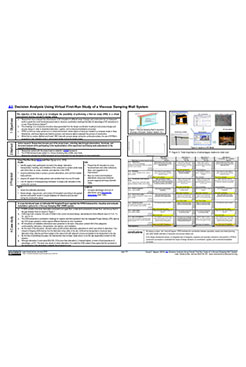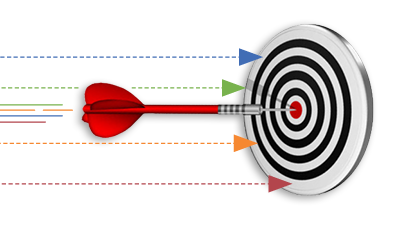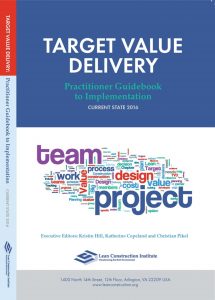A3 Thinking
An Introduction to A3
In the design and construction industry – as in all industries – complex problems arise daily. Each project contains hundreds of decisions containing thousands of variables, and sorting them out to arrive at the best outcome is critical.
A3 problem solving provides teams with a strategy to effectively and efficiently deal with problems that they encounter and decisions that need to be reached. In true Lean fashion, A3 process improvement brings the entire team into the collaborative problem-solving process and allows teams to embrace out-of-the-box solutions.
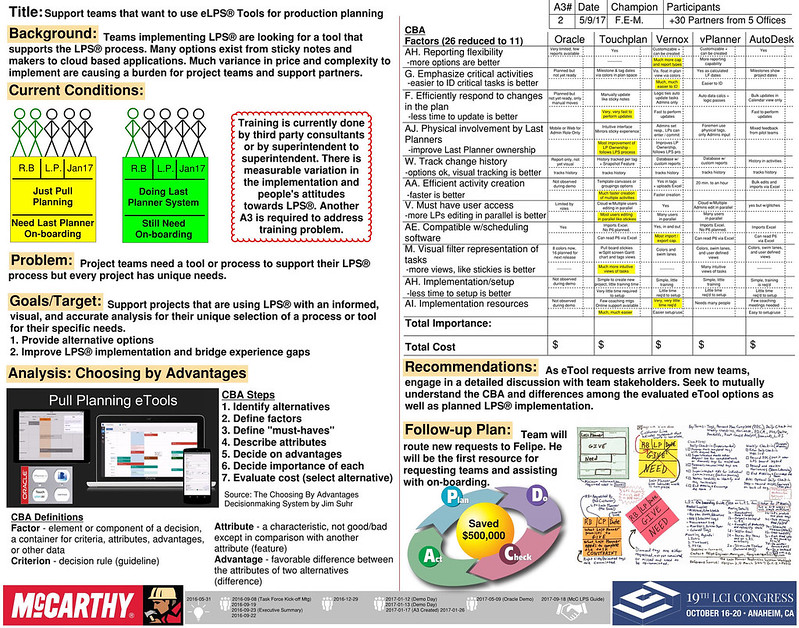
What is A3?
An A3 is a one-page report prepared on a single 11 x 17 sheet of paper that adheres to the discipline of PDCA thinking as applied to collaborative problem solving, strategy development or reporting. The A3 includes the background, problem statement, analysis, proposed actions, and the expected results.
The History
A3 thinking was developed by Toyota in the 1940s. Toyota believed that any problem should be capable of being explained and solved using one sheet of paper (an 11 x 17 sheet being the largest sized paper that is capable of being faxed and closest in size to the traditional A3).
The company also believed that if a problem is too complex to fit onto an A3 report, it should be broken down into smaller bits that would be solved individually. If your problem cannot fit onto an A3, you should reconsider the scope of what you are hoping to accomplish.
Who Uses A3 Strategies?
Today, A3 strategies are deployed across various industries that employ Lean thinking such as:
- Design & Construction
- Manufacturing
- Education
- Project Management
- Engineering & Architecture
- Healthcare
- Service Industries
LCI’s Meaning of A3
A3 thinking is an extremely useful tool when utilized correctly. By distilling the entirety of a problem on a single sheet of paper, A3 Lean thinking forces team members to collaborate and rationalize through the problem solving process. A3 thinking makes for more effective problem solving and produces written explanations that can then be passed on to senior management. An effectively completed A3 report will also build management’s confidence in the team and its ability to solve problems.
A3 Reporting
A well-written A3 report should show and explain the consideration that went into the counter-measure to the problem listed. Properly executed plans include the input of team members from all across the stakeholder spectrum and should allow members to emerge as leaders in its problem solving. A3 papers can also be referenced later, allowing the lessons learned during the process to be shared with future project teams.
Understanding A3 Thinking
A3 thinking does not provide a solution to the problem your team is facing. Rather, it guides your team’s process to help it reach the best possible countermeasure with the tools it has at its disposal.
An A3 report is to be filled out by one person on the team – the “champion” – who will gather assessments and intel from other members in a collaborative fashion. Bringing all of the knowledge and expertise of the team to bear when solving a problem is the best way to come to a satisfying outcome.
Problem Solving: An A3 Process
A3 thinking allows for many different types of decision-making. But ultimately, all decisions are fundamentally a form of problem solving. For example, A3 thinking can be deployed to guide the team in optimizing decisions during the design phase, or for solving a constructability challenge.
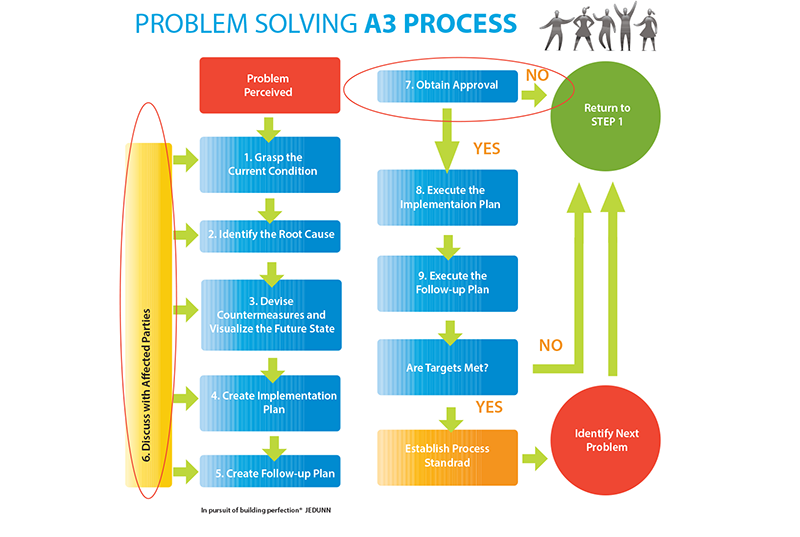
The First Step to A3 Thinking
The first step of the A3 process for problem solving is to correctly identify the problem. From unexpected lead times on materials to communication breakdowns among design teams, “problems” are in no short supply in the design and construction industry. Before engaging in A3, ask yourself the following questions about the problem you are working to solve.
Questions to Facilitate the Process
- What are you trying to address or solve?
- What is the current situation?
- What are clear Conditions of Satisfaction (CoS) I can develop?
- Where can I brainstorm and analyze the 5 whys/root cause ideas?
- What’s a recommendation I can put forth?
- What is my plan to implement the recommendation above (if applicable)?
State plan to check and adjust using the PDCA cycle.
More on the PDCA Cycle
PDCA stands for Plan, Do, Check, Adjust. Explore each element of this acronym for more information about how it supports both the problem solving questions above as well as A3 problem solving as a whole.
Plan
Identify an issue in your process and exercise continuous improvement by planning your course of change.
Do
Perform your case study by applying the corrective actions outlined in the “plan” stage in an experimental manner.
Check
Follow the performance of your experiment and measure it to determine whether it is having the desired effect.
Adjust
If your plan worked, implement the change to the necessary areas of your process. If it did not, determine what you will do differently next time and repeat the cycle.
A3 Reports for Solutions
While A3 reports broadly follow the PDCA cycle, the actual journey of an A3 process is a bit more granular. Let’s analyze the various steps and sections of an A3 report.
Plan
Title
Describe the problem, theme, or issue. List out all of the details including the champion’s name, date, and the names of all of the collaborators who will be helping with the report.
Background
Establish the business context & importance. Provide additional information on the problem being addressed.
Current State
Describe what is currently known about the problem. Note potential variables and roadblocks that may stop your team from solving this problem and additional information you hope you acquire.
Future State or Goal
Identify the desired outcome for your experiment. Identify the Conditions of Satisfaction (CoS) for the project.
Analysis
Analyze the situation and underlying cause.
Do
Recommendation
Provide a recommendation for process improvement that your team can implement for the future.
Check/Act
Follow-up
Create a follow-up/review process.
A3 Examples
A3 thinking is frequently applied in Lean design and Lean construction during all phases of the process for the purposes of making sound decisions. In the example below, A3 thinking is applied to the process of learning Lean design and construction techniques.

A3 Template
The Lean Construction Institute seeks to educate companies all throughout the design and construction industry on Lean practices and methods. Here is our A3 template which you can use to guide your decision-making processes.
A3 Training
The Lean Construction Institute offers A3 training as well as tools, events, education, and networking opportunities for Lean practitioners in design and construction all around the world. Whether you’re a Lean expert or are just learning about Lean for the first time, LCI can provide the tools you need for problem solving and continuous improvement in your business.
Lean Assessments
How strong is your Lean knowledge? Take a Lean assessment to determine your current state so you have a baseline for improvement. Lean assessments are available for individuals, teams, and organizations alike. Whether you’re new to Lean or are an experienced Lean practitioner, Lean assessments are a great way to get started at LCI!
TAKE ASSESSMENTMore Lean Topics
From 5s to IPD, explore more popular Lean design and construction topics below.


